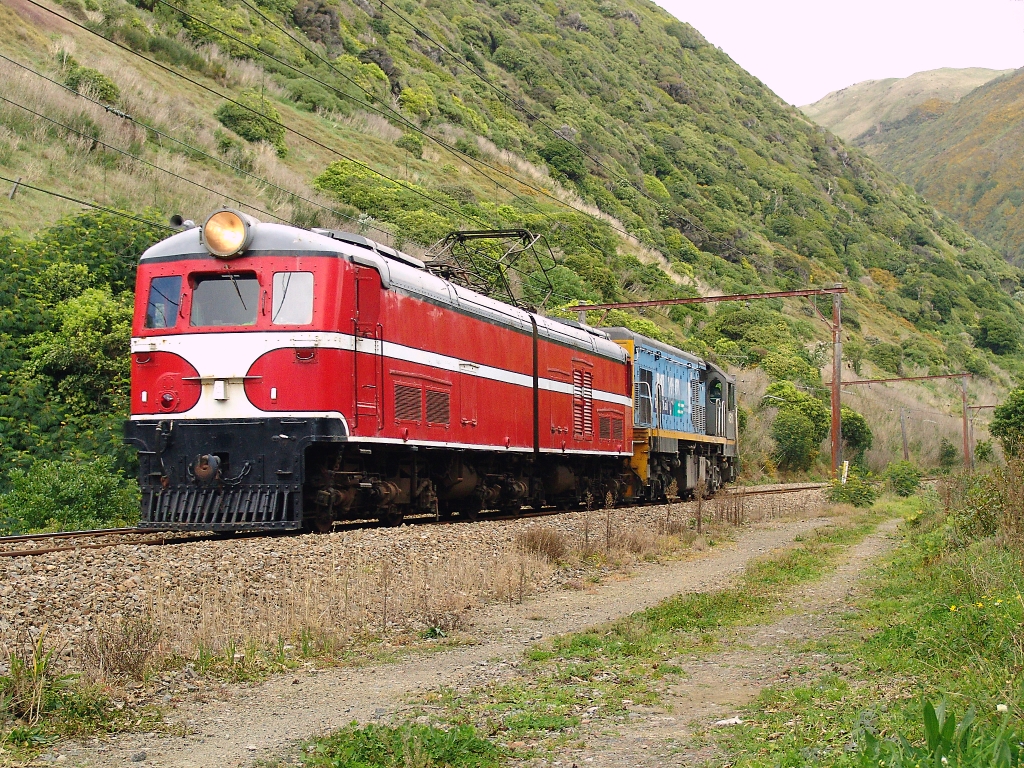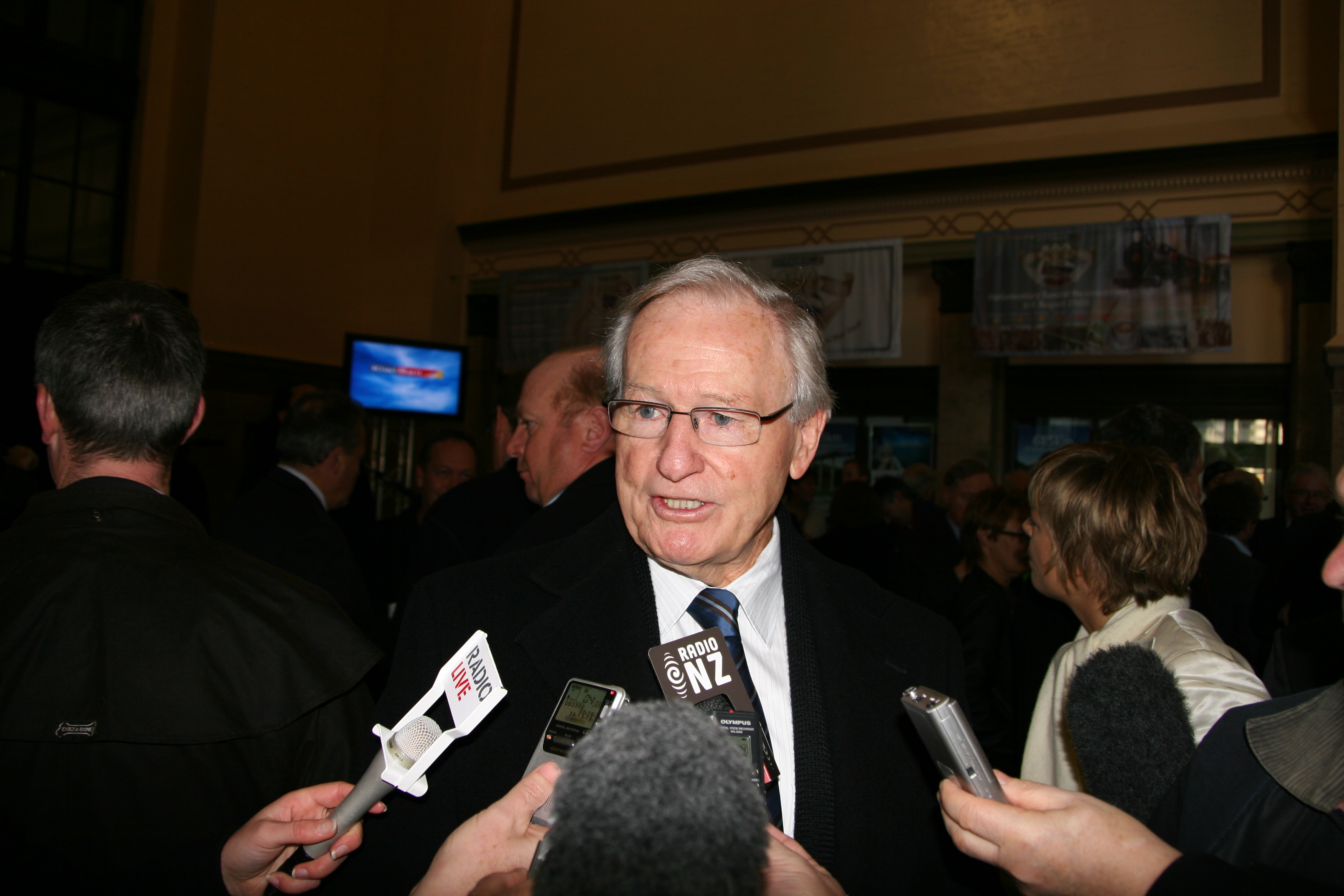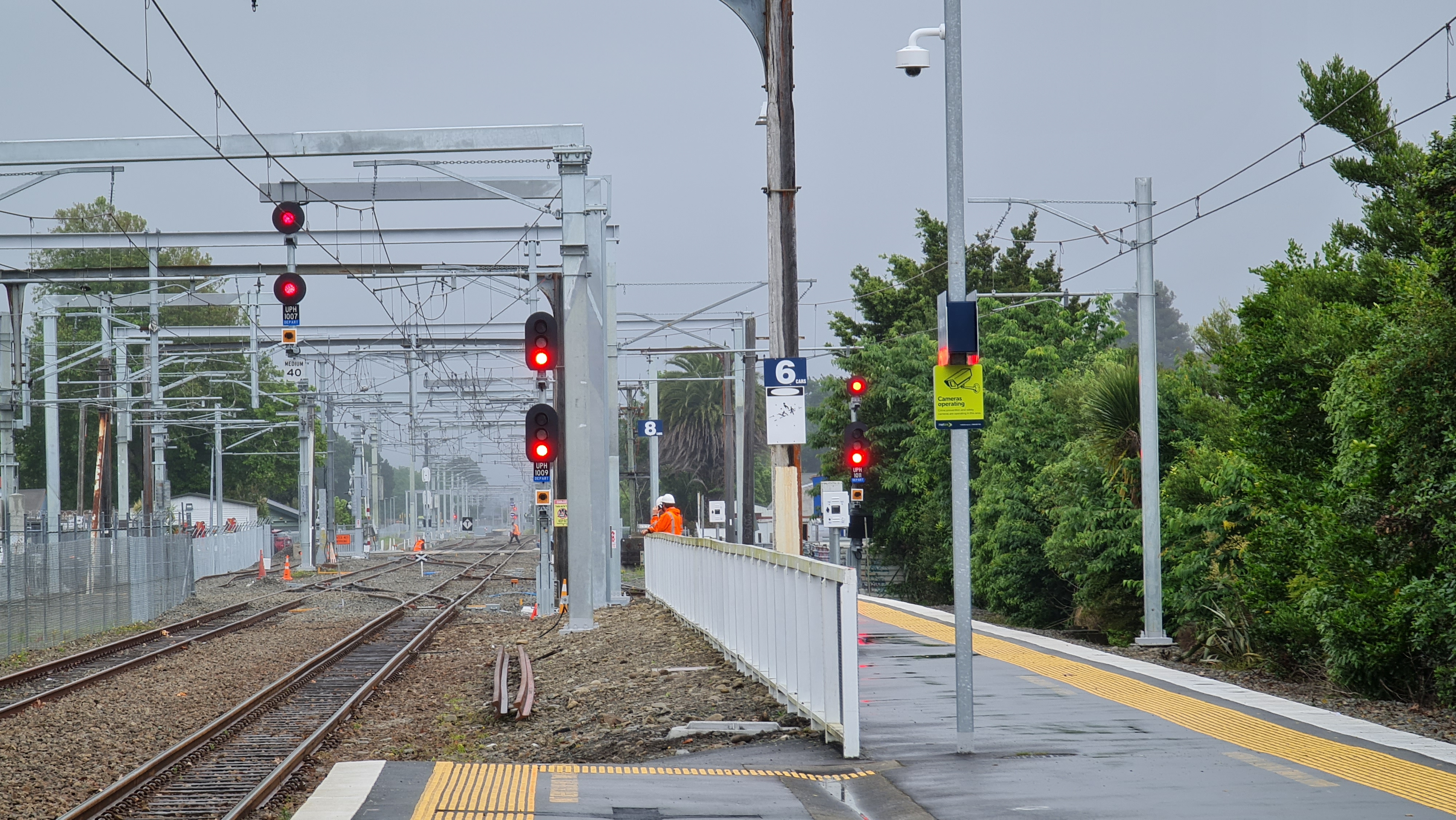|
North–South Junction
The North–South Junction is a section of single-track rail line about 7 km long, north of Wellington, New Zealand between the closed (2011) Muri railway station (north of Pukerua Bay railway station) and the (lower) Paekakariki railway station to the north. It is part of the Kapiti Line section of the North Island Main Trunk line between Wellington and Auckland, and part of the Wellington–Manawatu Line, built by the Wellington & Manawatu Railway Company (WMR). Because of the commuter traffic from Wellington to Waikanae plus freight traffic, the line north is double tracked to just before the bridge over SH59, before the Waikanae River bridge south of Waikanae railway station, and the line south from Pukerua Bay is double tracked to the terminus at Wellington railway station. The line is on an unstable hillside, the Paekakariki Escarpment, and with a two-lane section of State Highway 59 (formerly State Highway 1; to 7 December 2021) below, which runs along the edge o ... [...More Info...] [...Related Items...] OR: [Wikipedia] [Google] [Baidu] |
North–South Connection
The North–South connection (french: Jonction Nord-Midi, nl, Noord-Zuidverbinding) is a railway link of national and international importance through central Brussels, Belgium, that connects the major railway stations in the city. It is line 0 (zero) of the Belgian rail network. With 1200 trains a day, it is the busiest railway line in Belgium and the busiest railway tunnel in the world. It has six tracks and is used for passenger trains, or rarely for a maintenance train when work is to be done on the railway infrastructure inside the North–South connection itself, but not for freight trains. It is partially underground (around Brussels Central Station) and partially raised above street level. History During the late 19th and early 20th centuries, Brussels was served by two main railway stations: Brussels-North (opened in 1846) and Brussels-South (opened in 1869, replacing a nearby station of 1840). They are located just outside opposite ends of the Pentagon—an area ... [...More Info...] [...Related Items...] OR: [Wikipedia] [Google] [Baidu] |
Escarpment Track
The Escarpment Track is a hiking track between Pukerua Bay and Paekākāriki in the Wellington region of New Zealand. It forms part of the Te Araroa trail from Cape Reinga to Bluff. The track climbs to approximately above sea level, along a narrow route formed along a steep coastal escarpment. It overlooks a section of State Highway 59 known as Centennial Highway, and the North–South Junction section of the Kapiti Line and the North Island Main Trunk railway line. Track description The track can be walked in either direction. It is mostly single track, narrow and steep in many places, with significant drop-offs. The surrounding terrain is mostly covered in low growing vegetation, but there are some sections of taller vegetation and remnants of kohekohe forest. The track includes approximately of formed staircases, with around 1,500 steps and two suspension bridges. At the northern end of the trail near Paekākāriki, there is an old quarry that is now the site of a l ... [...More Info...] [...Related Items...] OR: [Wikipedia] [Google] [Baidu] |
KiwiRail
KiwiRail Holdings Limited is a New Zealand state-owned enterprise responsible for rail operations in New Zealand, and operates inter-island ferries. Trading as KiwiRail and headquartered in Wellington, New Zealand, KiwiRail is the largest rail transport operator in New Zealand. KiwiRail has business units of KiwiRail Freight, Great Journeys New Zealand and Interislander. KiwiRail released a 10-Year Turn-around Plan in 2010 and has received significant government investment in support of this in an effort to make KiwiRail a viable long-term transport operator. History Background Prior to the establishment of KiwiRail, rail transport in New Zealand has been under both public and private ownership. Government operators included the Public Works Department (1873–1880), New Zealand Railways Department (1880–1982), and the New Zealand Railways Corporation (1982–1990). New Zealand Rail Limited was split off from the Railways Corporation (which continued to own the land beneath ... [...More Info...] [...Related Items...] OR: [Wikipedia] [Google] [Baidu] |
Johnsonville Line
The Johnsonville Branch, also known as the Johnsonville Line, is a commuter branch line railway from the main Railway Station of Wellington, New Zealand to the northern suburb of Johnsonville via Ngaio and Khandallah. Transdev Wellington operates the trains under contract from the Greater Wellington Regional Council. In 2001, an estimated 1,043 passengers used the line on a working day. The line has seven tunnels and eight stations. Four stations (Crofton Downs, Awarua Street, Box Hill, and Raroa) are on a curve. Before arrival at the Crofton Downs and Awarua Street stations, the onboard announcement adds ''Please mind the gap when exiting the train''. There are three crossing loops: at Ngaio and Khandallah stations and below Wadestown in the Ngaio Gorge. History The line was built in the 1880s as part of the Wellington-Manawatu railway line constructed by the private Wellington and Manawatu Railway Company line, to connect Wellington to Longburn near Palmerston Nort ... [...More Info...] [...Related Items...] OR: [Wikipedia] [Google] [Baidu] |
Hutt Valley Line
The Hutt Valley Line is the electrified train service operated by Transdev Wellington on behalf of Metlink on the section of the Wairarapa Line railway between Wellington and Upper Hutt, New Zealand. History Construction The Hutt Valley line was the first railway out of Wellington, preceding the Wellington and Manawatu Railway Company's west coast route, which was later acquired by the New Zealand Government Railways and incorporated into the North Island Main Trunk. The first proposal for a railway line from Wellington to the Rimutaka Range was put to the Wellington provincial government by Robert Stokes in 1858, and five years later the government gave support to the idea. In 1866, the government's investigating committee approved the line and the Wellington, Hutt Valley and Wairarapa Railway Ordinance was passed on 2 July 1866. It authorised a line to be built to either gauge of , or a narrow gauge of ; but sufficient funds could not be raised in England and the rail ... [...More Info...] [...Related Items...] OR: [Wikipedia] [Google] [Baidu] |
Stage Coach
A stagecoach is a four-wheeled public transport coach used to carry paying passengers and light packages on journeys long enough to need a change of horses. It is strongly sprung and generally drawn by four horses although some versions are drawn by six horses. Commonly used before steam-powered rail transport was available, a stagecoach made long scheduled trips using ''stage stations'' or posts where the stagecoach's horses would be replaced by fresh horses. The business of running stagecoaches or the act of journeying in them was known as staging. Some familiar images of the stagecoach are that of a Royal Mail coach passing through a turnpike gate, a Dickensian passenger coach covered in snow pulling up at a coaching inn, a highwayman demanding a coach to "stand and deliver" and a Wells Fargo stagecoach arriving at or leaving a Wild West town. The yard of ale drinking glass is associated by legend with stagecoach drivers, though it was mainly used for drinking feats and ... [...More Info...] [...Related Items...] OR: [Wikipedia] [Google] [Baidu] |
Harry Higginson
Harry Pasley Higginson (1838–1900) was a British and New Zealand civil engineer who was notable for constructing the Wellington and Manawatu Railway Company (WMR) line from Wellington to the Manawatu in the 1880s. The WMR was a private company, as the government had decided not to build the line. Higginson also played an important role in the discovery of Dodo bones on the island of Mauritius in 1865. Higginson was born in Thormanby, North Yorkshire, England in 1838 and educated at the Collegiate School, Leicester. Engineering career He was apprenticed to Sir William Fairbairn in Manchester for five years, then constructed railways, canals and water works in Russia in 1860–61, in Mauritius from 1862 until 1866, and in England and in India. He became an associate member of the Institute of Civil Engineers while in India in 1868, and a full member in 1871. In 1872 Higginson was appointed as superintending engineer for railways and public works in the South Island. In 1878 he le ... [...More Info...] [...Related Items...] OR: [Wikipedia] [Google] [Baidu] |
James Fulton (civil Engineer)
James Edward Fulton (11 December 1854 – 6 December 1928) was a New Zealand surveyor and civil engineer. He was born in Outram, South Otago, New Zealand on 11 December 1854, and was the son of James and Catherine Valpy Fulton. He was survived by his wife and daughter (born 19 June 1887). He worked for a short time as an engineer in flax mill, before becoming a Public Works Department cadet. In 1875 he went to Napier and in 1878 was promoted to Assistant Engineer. He left PWD in 1880 and worked on the Kaihu railway. He became Resident Engineer of the Longburn-Waikanae section of the Wellington-Manawatu Railway from 1882 under Harry Higginson (with his brother Arthur Fulton), and the WMR manager and locomotive superintendent from 1889. He resigned in 1897 after accepting responsibility for an incident when his unofficial special train to Plimmerton with an engine and a carriage for his family met a freight train head on; trains were not normally scheduled on a Sunday! He w ... [...More Info...] [...Related Items...] OR: [Wikipedia] [Google] [Baidu] |
Samuel Brown (mayor)
Samuel Brown (1845 – 14 August 1909) was the Mayor of Wellington, New Zealand from 1887 to 1888. Brown was born in Ireland in 1845. He came to New Zealand in 1862, first settling in Invercargill having walked there from Dunedin. He erected Bendix Hallenstein, Hallenstein and Co's first business in New Zealand. Brown then moved to Wellington in 1864 where he was a merchant and contractor, responsible for the Wellington tramway system, Wellington steam tramways. He also obtained the No 13 or Paekakariki Contract for the tunnels and central section of the Wellington and Manawatu Line for the Wellington and Manawatu Railway Company. With access difficulties this was the most difficult contract for the line; see North–South Junction. He was also involved in the construction of the Midland Line, New Zealand, Midland and Westland Railways. He built the first portion of the Wellington Gas Company, Wellington Gas Works, the Maginnity Street drill shed, and the first lighthouse at Cape ... [...More Info...] [...Related Items...] OR: [Wikipedia] [Google] [Baidu] |
Otaihanga
Otaihanga is on the Kapiti Coast of New Zealand's North Island. It is just north of Paraparaumu on the south bank of the Waikanae River and is roughly 55 km north of New Zealand's capital city, Wellington. Its name is Māori for "the place made by the tide".Kapiti Coast District Council"Tourism", accessed 28 November 2007. The New Zealand Ministry for Culture and Heritage gives a translation of "place of Taihanga personal name for ''Ōtaihanga''. Demographics Otaihanga statistical area covers . It had an estimated population of as of with a population density of people per km2. Otaihanga had a population of 804 at the 2018 New Zealand census, an increase of 69 people (9.4%) since the 2013 census, and an increase of 54 people (7.2%) since the 2006 census. There were 306 households. There were 393 males and 411 females, giving a sex ratio of 0.96 males per female. The median age was 46.3 years (compared with 37.4 years nationally), with 132 people (16.4%) aged under ... [...More Info...] [...Related Items...] OR: [Wikipedia] [Google] [Baidu] |



.jpg)

